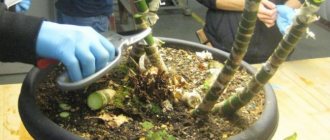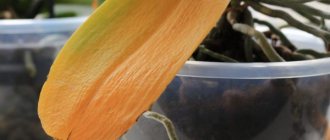The cactus is considered one of the most unpretentious plants. But if not properly cared for, it begins to wither and rot. It can be difficult to detect the problem right away, but if you succeed, you can save the “green hedgehog.” Let's figure out why the cactus starts to hurt and what to do in such cases.
Rotting from within
This form of the disease is considered the most severe, and not because it necessarily leads to death, but because the lesion can be seen even when the flower cannot be resuscitated. To avoid losing a flower, take a closer look at it more often. At first, small spots appear on its surface, over time they increase in size and become clearly visible. The spots can be either light or dark, and in most cases they signal rotting from the inside, the scale of which is much more serious in the body of the plant than outside.
Apply pressure to the affected area. If it is soft, then it is time to take rescue measures. Most likely, the flower was affected by one of several diseases.
• Dry rot . It is also called fomoz. The disease is fungal in nature, and its causative agent is the fungus Phoma rostrupin. First, spots appear on the cactus - dry and light, slightly indented. In appearance, they resemble crusts riddled with cracks. Even with slight pressure, this crust is damaged, and a substance similar to mush comes out from under it.
• Brown rot . It makes itself felt when the flower is infected by a bacterium called Erwinia. Brown or brown spots appear between the ribs of the cactus, and the trunk of the plant becomes limp.
• Rhizoctoniosis. The disease occurs as a result of infection of the flower by the fungus Rhizoctonia, which favors young plants. Infection of the entire cactus occurs due to the fact that the fungus spreads throughout all feeding vessels. The rotting in this case is wet and is easier to notice than in all other cases.
• Black rot or Alternaria blight . It is caused by fungi of the genus Alternaria radicina, which provoke the appearance of shiny brown spots on the flower. The disease progresses very actively, so measures must be taken immediately, otherwise the cactus will not be saved. Most often, black rot occurs due to high humidity in the room. Such conditions can also lead to rotting of the root system.
Is it possible to save a flower if it is affected by one of the listed diseases? Unfortunately, the answer to this question is not positive in all cases. First, assess the scale of the problem. Remove your “prickly friend” from the pot and inspect it from all sides. Feel it to understand the area of the lesions. If they are small, then there is hope. Just carefully cut out the rot and treat the wounds with sulfur or brilliant green so that the fungus does not penetrate deeper. After this procedure, the flower must be planted in fresh soil, and it is advisable to change the pot.
If you realize that the entire body of the plant has become soft and when palpated, deep indentations remain on it, then you can cut off the top to root or graft to another similar plant. It happens that the top also suffers. In such situations, it is better to get rid of the cactus.
Dry rot
It is quite difficult to identify this disease. usually discovered when the cactus is in its “death” stage.
What to look for during inspection?
When infected by Phoma rostrupin fungi, the plant turns pale and begins to dry out. Most often this goes unnoticed. Then dry crusts covered with cracks appear on the body of the cactus, and when pressed, your finger falls into the trunk. If the stem is cut, the cactus turns out to be empty, dried out inside.
Prerequisites for the disease
Introduction of the Phoma pathogen through wounds on the trunk of a cactus. When replanting or transporting a plant, you can accidentally damage the integrity of its body. In such cases, the fungus penetrates through the damaged areas, and the cactus becomes infected.- Violation of wintering conditions. If wintering is not organized correctly, the cactus’s resistance to infectious diseases decreases.
- Excessive watering. Excess moisture causes rotting of the root system, which weakens the plant's resistance to infectious diseases.
- Vaccination with a sick cactus. Only healthy plants should be grafted.
- Replanting into soil previously used for another plant. If a cactus suffering from dry rot previously grew in the soil, such a substrate should be destroyed and under no circumstances used for other plantings.
Can anything be done?
No effective methods have been developed to combat dry rot. The disease develops quickly and ends in the death of the cactus. To prevent this disease, plants should be treated quarterly with fungicides, and the conditions for keeping cacti and their wintering should be observed.
Rotting at the base
Cacti usually begin to rot at the base due to errors in care. This form of the disease is considered the most common. The chances of saving a prickly pet are usually high, the main thing is to detect the problem in time. To do this, take a closer look at the bottom of the plant. In a diseased specimen, a brown rim forms there. It is easy to identify: it is usually located at the very border of the flower body with the ground. From the slightest touch, the flower can tilt greatly, or even fall completely. Why does this happen?
• Late blight. It is caused by fungi with the appropriate name Phytophtora, which primarily affect the root system.
• Helminthosporosis . The problem is also fungal in nature, and the causative agent is the fungus Helminthosporium cactivorum. Symptoms of the disease are watery brown spots at the very neck of the flower. Most often, recently planted young specimens suffer due to excess moisture. Beginning gardeners who have never cared for succulents before face a problem. Remember that these plants like dry soil, but too much water will cause their roots to rot.
• Lack of light . This is one of the most common mistakes in care. Owners of such plants do not provide enough sunlight during the winter months and do not care about temperature conditions. Cacti love warmth, so the room in the cold season should be at least +12 degrees. Deviation from this norm is fraught with rot.
• Lack of moisture . The fact that a cactus loves dry soil does not mean that it does not need watering at all. Find out how much moisture your flower needs depending on its variety and type, and strictly follow the recommendations.
If your hedgehog's roots have rotted, follow the proven procedure. First, free it from the soil, wash the roots under running water and examine them to determine the extent of the damage. Remove rotten areas of roots with a reserve so that the fungus does not continue to spread throughout the healthy tissues of the flower. Be sure to treat the cut areas with copper sulfate or sulfur. When the root system of the cactus dries, fill a new pot with sand and plant the reanimated flower there.
After this procedure, water your green pet rarely and through a tray. This will require little water. Keep the flower in such conditions until it takes root, and then transplant it to a new place.
How to care?
Cactus is a plant that does not require special attention. However, certain rules must be followed to avoid infection with rot.
- This plant requires a lot of light; the cactus should be placed on or near a windowsill.
- The cactus should be watered as needed, adhering to the principle “the warmer the room, the more abundant the watering,” but not more than once every 2 days.
- During the dormant period, water the cactus once every 1.5-2 weeks, monitor the temperature and lighting in the room.
Caring for a cactus should be approached carefully and responsibly, although it does not require as much effort as other indoor plants. With the right approach, the cactus will delight its caring owners for many decades.
What to do if mold appears?
To treat mold, which often affects young plants, manifests itself in the form of plaque and leads to rotting, folk remedies will help. Prepare a solution from one tablespoon of baking soda, the same amount of laundry soap and a liter of water (preferably boiled). Spray the flower once a day. An alternative to this remedy is a pale pink solution of potassium permanganate: about five crystals per liter of water. Treat a diseased cactus once every three days and at intervals of three days. Mustard powder in the amount of half a teaspoon dissolved in a liter of water also helps.
You can prepare a preparation from five grams of copper sulfate, 15 grams of liquid laundry soap and 200 milliliters of boiled water. Please note: first you need to dilute the copper sulfate, and then, stirring constantly, add soap.
If the disease on your succulent is severe, try using fungicides. Give preference to topaz and foundationazole, which are more suitable for indoor flowers. When preparing the product, strictly follow the instructions on the package. Three or four sprays are enough.
The best cure for all diseases is prevention, which, in fact, is no secret. To make your cactus resistant to diseases, fertilize it at least occasionally. Mineral, potash and phosphorus fertilizers are suitable for this. At the same time, spray the cactus with sulfur. The best time for prevention is summer and early autumn.
External signs of rotting cactus roots
If the plant has acquired a pale tint or turned yellow, or the stem has stopped shining, this indicates rot. The same phenomenon occurs when a succulent shrinks. Signs when the watering regime is normal and the plant has entered the vegetative phase. A bad sign is a stem tilting to one side. A healthy plant should not have spots of any etiology or texture (dry, wet, brown or bright). A dent on the left or right, closer to the top of the cactus, also indicates rotting.
If the plant does not grow in season, this is a bad sign and indicates a serious disease. For a number of exotics, “wintering” with rest in summer is considered acceptable. Such cacti include rebutia and ailostera. A constantly wet substrate that does not dry out after watering for a long time indicates problems with the roots.
You can compare the drying period of the soil by placing several containers with plants nearby and watering them at the same time. Often the onset of rotting occurs unnoticed, but it can be identified by the appearance of a dark-colored rim at the bottom of the thick stem. If the roots are damaged, the plant does not sit tightly in the ground and may bend or fall to the ground.
How to resuscitate when a flower is completely damaged?
If rotting has spread throughout all tissues, then the cactus is difficult to save. The plant is removed from the pot, the dead parts are removed with a clean knife, and treated with Fundazol or Topaz. If the crown is intact, then the stem is cut in the form of a blunt pencil. The area is powdered with activated carbon and left to dry for a week in a place without sun. After 7 days, the patient is fixed with sticks over a pot of sand.
Do not water for a month, only spray.
What are the chances of rehabilitation?
The more the cactus is damaged, the less opportunity for regeneration. If the disease has affected 80% of the tissue (especially on top), then treatment will not help. Large specimens with a fleshy stem can be put on intensive care, but small ones and seedlings often die.
Rotting of cacti is a dangerous transformation that is caused by care errors, diseases or parasites. To prevent a problem from occurring, you need to follow the rules of agricultural technology. The amount of watering for succulents depends on the time of year and temperature. If the plant is sick, then resuscitation must begin.
Bad light
Most succulents need a lot of bright or even direct sunlight to thrive - cacti will not do well in a dark corner in the back of the room on the desktop near the computer, where everyone is trying to place them supposedly “to neutralize harmful radiation.”
Therefore, if you want to provide these plants with a blooming and healthy appearance, place them on southern, southwestern or southeastern windowsills. However, you need to keep in mind that in the summer heat, direct sunlight can burn some plants. Therefore, it is necessary to take into account the characteristics of each species - if most cacti feel good there all day, then, for example, gasteria and crassula will have to be shaded at the height of the day so that they do not get sunburn.
If you don’t have very bright windows in your apartment, you may need to get plant lights to create favorable living conditions for succulents.
An indicator that a succulent is dark can be a general depressed appearance of the plant, a pale appearance of its natural color, and especially the stretching and bending of the stems in search of light.
Also, many succulents do not like constantly changing the position of the pot in relation to the light source - they can slow down their development or refuse to bloom altogether.
Preventive measures
To avoid questions about how to save a cactus, it is advisable not to initially expose it to risks. Firstly, you should ensure the most comfortable climate - dry, warm, without sudden temperature changes. Secondly, the root system must be ventilated due to the loose structure of the soil, the presence of heterogeneous mineral additives (stones, sand) and an air-permeable drainage layer. In addition, it is important:
opryskivanie-kaktusov-iz-pulverizatora-928×1024.jpeg
Care
Proper wintering is very important for a cactus . From November to March it should be kept in a bright, cool place at a temperature of 8-12 degrees above zero, without watering, fertilizing or drafts. It is necessary to bring them out of hibernation gradually - do not water them abundantly right away.
As the cactus grows, it needs to be transplanted into a new, larger pot, making sure that the soil level is the same as in the old container.
In general, an unpretentious desert inhabitant still needs a timely reaction from its owner to any negative changes in appearance or well-being. Following the care recommendations will help you to contemplate a healthy cactus in your interior for many years, because any illness is always easier to prevent than to treat.
Is it possible to save a dying cactus and how to do it correctly? Causes of the disease and care tips
All plant growers, especially beginners, encounter problems when growing cacti.
Indoor cacti, despite their generally recognized resilience, get sick especially often and, so to speak, in a variety of ways. A cactus can begin to lose spines and shoots, dry out and become dull for completely different reasons.
Knowing the symptoms and understanding the nature of the diseases, you can have time to take measures to save the cactus from death so that it does not dry out completely.
Causes of diseases
Being naturally adapted to extreme heat and drought, desert succulents react extremely negatively to excess humidity, especially at low air temperatures. Forest species show greater resistance to such a climate, but for them too frequent contact with water can be disastrous.
0db05c2fa4cb50a82aaa855069ffaf97_i-2806.jpg
The most common mistakes gardeners make when growing cacti at home are:
1. Unsuitable substrate. Representatives of the cactus family need light mineral soil consisting of sand, small stones and a minimum amount of garden soil (up to 30% for spherical and up to 50% for deciduous species). Components such as black soil, peat, humus and other organic matter are unnatural for this group of plants. They not only over-moisten the roots and interfere with normal air exchange, but can also lead to bacterial contamination of succulents, as they provide a breeding ground for many microorganisms.
grow-cactus-indoors-step-7.jpg
2. Lack of watering. Oval-shaped desert cacti with needles and “mouths” sometimes survive without water for six months or more. This is due to their ability to absorb moisture from the air. If you stop watering forest species (Decembrist, epiphyllum, rhipsalis, etc.), then within a month or two you will see wilting of leaves or stems, falling flowers, and fading color.
foto5_cvetok_dekabrist_vyanet_chto_delat.jpg
3. Excessive watering. The first signs of overwatering of cacti are swelling of the body and loss of ribbing. Next, straw, brown or rust-colored spots may appear, the stem becomes soft, the needles wither and fall off. When pressed, the skin of the flooded plant is easily damaged and juice flows out. This indicates a fungal infection that arose precisely because of the dampness of the soil.
15510.pgfbgc.840.jpg
4. Hypothermia. Spiny pets tolerate the winter dormant period best at temperatures from +8 to +12 °C. At this time, it is enough to water desert species once a month (literally a few drops of water), forest species - once every 10-15 days. If the plant is left in the cold (any thermometer reading below 0) and the liquid in its cells freezes, you will have to forget about restoration.
1019065_736b24946267013d3d97b72039b18c08_800.jpg
5. Pest damage. Thrips, scale insects and spider mites from indoor flowers can from time to time settle on succulents. It is best to combat them by spraying with insecticides, treating all infected plants at once on an open balcony or on the street.
56027.p0jlic.790.jpg
Each of the listed factors, and even more so a combination of several, can provoke drying out or rotting, first of the root system, and then of the ground part of the cactus. For successful recovery, all these mistakes must be corrected.
Treatment Options
The most difficult question is how to save a cactus if it begins to rot from below. If the succulent is affected by rot, you can use the following techniques to save it:
- removal of damaged parts and replanting in clean soil;
- rooting the crown of the stem.
If the rot has already spread to the stem, it is better to graft the plant.
For the treatment of succulents the following are used:
- Captan. The fungicide is useful against many fungi and bacteria. It is important not to use it together with lime.
- Fundazol. Fights fungi well.
- Colloidal sulfur. An effective drug in the treatment of fungal infections and the destruction of mites.
- Quinozol. Antifungal and antibacterial agent.
- Maksim. It disinfects the soil well. Used for cases of fusarium, fomosis, and wet rot.
- Topaz. Saves from rust and powdery mildew.
- Copper oxychloride. Used for late blight, spotting, anthracnose, rust, bacteriosis.
- Fitosporin. A remedy against fungal and bacterial infections. Particularly good for prevention or in the initial stages of the disease.
If a cactus becomes infected with dry rot, the plant will disappear. Since it will not be possible to revive the cactus, the disease is easier to prevent.
Removing stains on a cactus using surgery is not very effective. This can only be done with branched varieties. The scars themselves disfigure the plant, but the process of spreading the disease does not stop. The disease can be contained or completely stopped by treating with fungicides.
Cutting off the roots
If the roots are rotting, only cutting off the damaged areas will help. Since it is impossible to save the cactus otherwise. After this, the plant is kept in a weak solution of manganese (about 30 minutes), the sections are sprinkled with coal powder, dried and planted in disinfected soil.
It is not recommended to water the flower in the next 3 weeks.
Replanting a cactus
What to do if the cactus is rotting from below? If a flower is damaged, you should try to replant it. The pot and soil must be new and disinfected.
To transplant a plant:
- pulled out from an old pot;
- freed from the earth;
- roots and stems are cleaned of damaged areas;
- the whole plant is washed with hot (about 50 degrees) water with the addition of a fungicide;
- the sections are sprinkled with crushed coal and cinnamon powder;
- dried in a vertical position in air for up to 5 days;
- planted in new soil.
Important ! The root collar should protrude above the soil surface.
After transplantation, the cactus is not watered for about 5 days; it is carefully shaded.
And others
You can cure a succulent by pruning all affected areas. The main thing is to remove rot on the cactus to healthy tissue, treat it with disinfectants (charcoal, sulfur, cinnamon powder). If the top is damaged, it can be cut off and the rest of the cactus used as rootstock. Subsequently, fungicides are used, depending on the disease.
You can also try to save the succulent by re-rooting. That is, the roots are completely cut off. Only the healthy ground part is taken for planting. It should be sharpened like a pencil, left to dry in an upright position and placed in a glass of water.
After 10-14 days, roots will appear on it and the seedling can be planted in an individual pot. Then the plant is watered, and after a while the water is drained from the pan. The next watering is needed only after 20-22 days.











